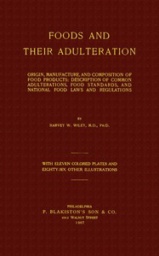

Foods and Their Adulteration (1907)
by Harvey Washington Wiley


The meat and bones selected should be fresh, free from all impurities and be derived solely from healthy animals as soon as they have been slaughtered. Inasmuch as the shape of the material used is of little consequence the parts of the carcass that are cut away in the preparation of the usual cuts of the marketable meats are utilized for stock making. The flesh should be cut into fragments of proper size and the bones broken up into small pieces. This material with the appropriate amount of water and salt is placed in a vessel capable of being closed in such a way that no aqueous vapor will escape, and a slight degree of pressure, equal to the half of an atmosphere, can be sustained. Simple forms of digesters are made for this purpose which are perfectly safe at low pressure and supplied with a safety valve so as to allow steam to escape if the pressure runs too high. Several hours of digestion are necessary for the preparation of stock, and if an ordinary vessel is used care must be exercised that the liquid does not evaporate so as to make the mass dry. Stirring from time to time assists the solution of the soluble substances. After the extraction is complete the liquid contents are poured off and the solid material pressed gently to separate the liquid held in solution. The mass is then put in a cool place and allowed to stand until thoroughly cooled and all the fat particles are collected at the top. The fat is then removed and the resulting liquid strained to remove any solid particles. The clear solution thus obtained is set aside and used as stock in the preparation of the various forms of soups. When properly flavored and used by itself it produces the soup known as consomme.🏁
Global Leaderboard
| # | Player | Time | Duration | Accuracy | WPM | pp | |
|---|---|---|---|---|---|---|---|
| 1 | |||||||
| 2 | |||||||
| 3 | |||||||
| 4 | |||||||
| 5 | |||||||
| 6 | |||||||
| 7 | |||||||
| 8 | |||||||
| 9 | |||||||
| 10 |


The meat and bones selected should be fresh, free from all impurities and be derived solely from healthy animals as soon as they have been slaughtered. Inasmuch as the shape of the material used is of little consequence the parts of the carcass that are cut away in the preparation of the usual cuts of the marketable meats are utilized for stock making. The flesh should be cut into fragments of proper size and the bones broken up into small pieces. This material with the appropriate amount of water and salt is placed in a vessel capable of being closed in such a way that no aqueous vapor will escape, and a slight degree of pressure, equal to the half of an atmosphere, can be sustained. Simple forms of digesters are made for this purpose which are perfectly safe at low pressure and supplied with a safety valve so as to allow steam to escape if the pressure runs too high. Several hours of digestion are necessary for the preparation of stock, and if an ordinary vessel is used care must be exercised that the liquid does not evaporate so as to make the mass dry. Stirring from time to time assists the solution of the soluble substances. After the extraction is complete the liquid contents are poured off and the solid material pressed gently to separate the liquid held in solution. The mass is then put in a cool place and allowed to stand until thoroughly cooled and all the fat particles are collected at the top. The fat is then removed and the resulting liquid strained to remove any solid particles. The clear solution thus obtained is set aside and used as stock in the preparation of the various forms of soups. When properly flavored and used by itself it produces the soup known as consomme.🏁